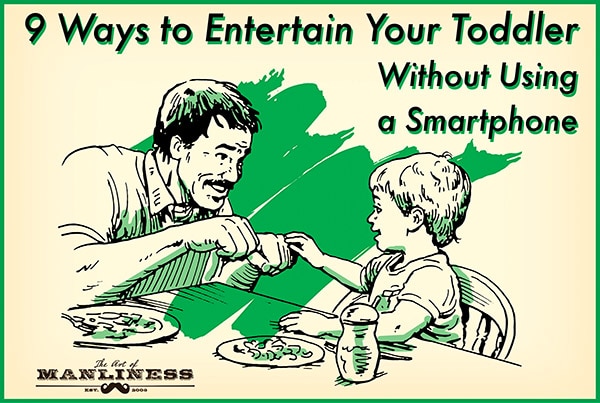With our archives now 3,500+ articles deep, we’ve decided to republish a classic piece each Sunday to help our newer readers discover some of the best, evergreen gems from the past. This article was originally published in October 2015.
You’re in a public place — say a restaurant or a doctor’s waiting room — and it’s taking longer to get your food or have your name called than you expected. Your toddler is starting to get restless. And cranky. Real cranky. She’s whining and teetering on the edge of a crying fit, and the other folks around you are glancing over with irritated, disapproving looks.
You don’t have any toys or books on you, making it extremely tempting to just shove your smartphone into your tyke’s pudgy little hands to instantly shut off the waterworks.
But, the idea that you should turn to your phone whenever you feel unhappy or bored is not exactly the kind of lesson you want to teach her; you want her to grow up to be able to entertain herself, absent a technological device. So you think about busting out some pen and paper games like hangman or tic-tac-toe, but she’s preliterate and only understands strategy in terms of figuring out how to poop so no one sees her.
What to do?
Well, with a few completely accoutrement-free games in your metaphorical back pocket, you can easily improvise some entertainments that’ll keep your little one happy and engaged before her chicken nuggets finally arrive. Here are 9 fun, brain-boosting ideas to keep on deck; some work better depending on age and ability, many can be modified to meet your toddler’s level of cognition (which is right around that of a golden retriever), and some will be equally enjoyed by the preschooler set on up. Experiment and see what captures your kiddo’s attention.
1. Name That Tune
Hum a familiar song (“Twinkle, Twinkle Little Star,” “Old McDonald,” etc.), and see if your child can identity and name it.
2. What’s Missing?
This is a great one to do at the table at a restaurant. Take a few objects — a fork, spoon, and sugar packet, for example — and tell your kid to take a careful look at the collection. Then cover the items with a napkin, and remove one of the items without him being able to see which one (lift the end of the napkin nearest you for cover as you withdraw the item). Now remove the napkin altogether, and ask your child to name which item is missing.
3. Who Am I?
Pick an animal, and then let your kid ask questions to try to get at your identity. E.g., “Do you roar?†“Do you live somewhere cold or hot?†“Are you furry?â€
4. Touch Something That Is…
Ask your child if he can touch something that is X color. “Can you touch something that is red?†“Can you touch something blue?†He can touch anything within his reach — the table, his clothes, your clothes, etc. If it’s someplace where he can walk around without bothering other people, you can make the game mobile.
5. Shape Hunt
Ask your kid if she can see anything in her environment with a certain shape. “What do you see that’s a circle?†“What do you see that’s a triangle?â€
6. I Spy
Classic entertainment that’s good for the slightly older kid who’s able to process the idea behind this guessing game. Pick an object both you and your kid can see, and then say, “I spy something, and it’s ____.†If your child has a basic understanding of the alphabet and a modest vocabulary, fill in the blank with a letter. “I spy something, and it begins with the letter C.†It can help to sound it out: “Ca-Ca-Ca.†For the preliterate set who knows only their colors or shapes, substitute those categories instead. You can also describe the object’s properties: “I spy something, and it’s rough and scaly/smooth and shiny.â€
7. What Is Different?
You do need a pencil and paper for this, but that shouldn’t be a problem since like all great men in history, you’ve adopted the habit of carrying a pocket notebook with you. Divide a piece of paper into a quadrant. In three squares, draw the same shapes/pictures/pattern. In the fourth square, draw something different. So for example, you could draw dogs in three of the squares and a cat in the fourth, or a triangle in three of the squares, and a diamond in another. Have your kid point to the panel that differs from the rest. The more advanced your child, the harder you can make it; try doing 5 circles in three of the squares, and 6 in the fourth, or different patterns like XXOOXX in three squares, and XXOXX in the fourth.
8. Simple Riddles
Come up with easy riddles for your child to solve. For example: “I have four legs and am covered in fluffy white wool. What am I?†or “I’m shaped like a circle, I have two hands, and numbers all around me. What am I?â€
You can find a whole treasury of riddles for kids of all ages here.
9. Hidden in the Hand
Let your kid see your open, empty hands. Then put an object like a coin in one of your hands and close both of them. Put your hands behind your back and switch the object back and forth between them. Bring your closed hands back in front of you, and ask your child to guess which one is holding the object.
Ideas found in The Everything Toddler Activities Book


